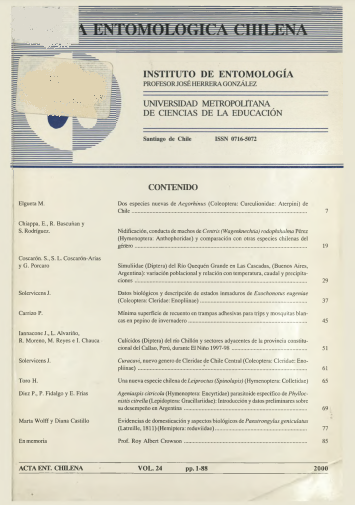Contenido principal del artículo
jul 7, 2022
Resumen
Counting time of insects trapped on sticky traps might be reduced, considering only part of the plates,
afler examining their distribution on the surface of the traps. This work examined the possibility for
Frankliniella occidentalis and Trialeurodes vaporariorum, two pests of greenhouse cucumbers, in a given
area of standard 10 x 13 cm sticky traps. Tests were carried out with yellow and blue traps, counting those
insects traped on whole traps, and on seven different distribution areas. Frankliniella occidentalis represented
more than 95% of the trips species, and whiteflies were 100% Trialeurodes vaporariorum. The expected
capture was compared with catches on each design using the G fitness test. For whiteflies, 96% of the tests
fitted the expected valúes. For thrips, 32% and 13% did the same for yellow and blue traps, respectively.
Paired t test were used to determine if catches on each design were higher or lower than average on the
whole-trap counts. Whiteflies tended to be more uniformly distributed on the surface than the thrips,
which showed some grouping, especially on blue traps. Counting the insects on two 2 cm wide horizontal
strips on the top and bottom edges gave counts not signifícantly different (based on surface area) from
whole-trap figures, for both whiteflies and thrips. This technique would reduce counting time by 70%
compared with whole-trap counts, because only 30% of the trap area is counted.


